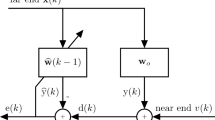Abstract
The relationships for optimizing a selective estimate of the correlation matrix of classical (initial and modified) and fast projection algorithms in a complex noise situation were determined. Model investigations on the comparison of the resolution of classical optimized algorithms with the characteristics of two variants of fast projection algorithms were performed. The algorithms were compared using the criterion of a decrease in the time and reduction of the angular zone of the loss of a contact with a weak target when it intersects the path of an intense interfering signal. The relationships that correspond to the most economical realization of the fast algorithm were determined.
Similar content being viewed by others
References
J. Capon, Proc. IEEE 57 (8), 1408–1418 (1969).
H. Wang and M. Kaveh, IEEE Trans. Acoustic, Speech and Signal Proces. (ASSP) 36 (8), 1272–1281 (1988).
H. Krim and M. Viberg, IEEE Signal Proces. Mag. 13 (4), 67–94 (1996).
D. N. Lekhovitskii, D. V. Atamanskii, and I. G. Kirillov, Antenny, No. 2, 40–54 (2000).
O. P. Cheremisin, M. V. Ratynskii, A. A. Komov, and A. E. Pushin, Radiotekh. Elektron. 39 (2), 259–263 (1994).
M. V. Ratynskii, Adaptation and Superresolution in Antennae Lattices (Radioisvyaz’, Moscow, 2004).
V. V. Karavaev and V. V. Sazonov, Statistical Theory of Passive Location (Radio i svyaz', Moscow, 1987).
G. S. Malyshkin, Acoust. Phys. 60 (3), 309–322 (2014).
G. S. Malyshkin and Yu. V. Shafranyuk, Fundam. Prikl. Gidrofiz. 6 (1), 66–77 (2013).
G. S. Malyshkin, Fundam. Prikl. Gidrofiz. 6 (1), 78–89 (2013).
G. S. Malyshkin and G. B. Sidel’nikov, Acoust. Phys. 60 (5), 570–587 (2014).
G. S. Malyshkin and A. S. Kuznetsova, Fundam. Prikl. Gidrofiz. 9 (2), 73–80 (2016).
G. S. Malyshkin, A. S. Kuznetsova, and G. B. Sidel’nikov, Acoust. Phys. 62 (2), 235–243 (2016).
Yu. S. Beletskii, Methods and Algorithms of Contrast Detection of the Signals on the Background of Noise with A Priori Unknown Characteristics (Radiotekhnika, Moscow, 2011).
Author information
Authors and Affiliations
Corresponding author
Additional information
Original Russian Text © G.S. Malyshkin, 2017, published in Akusticheskii Zhurnal, 2017, Vol. 63, No. 2, pp. 196–208.
Rights and permissions
About this article
Cite this article
Malyshkin, G.S. The comparative efficiency of classical and fast projection algorithms in the resolution of weak hydroacoustic signals. Acoust. Phys. 63, 216–228 (2017). https://doi.org/10.1134/S1063771017020099
Received:
Published:
Issue Date:
DOI: https://doi.org/10.1134/S1063771017020099



